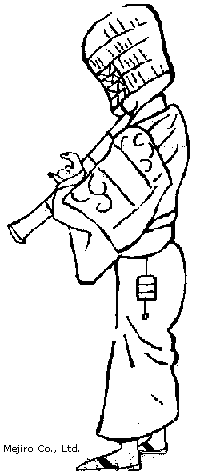|
|
SHAKUHACHI and ZEN
The Shakuhachi was used by a Zen priests' school, as a means for Meditation.
Early in the Edo period (17th century), a sect of Zen priests, named Fuke-Shu, who played the bamboo flute appeared.
They called themselves "Komuso" - "Priests of Emptiness and Nothingness".
In 1642 their parent temple, Meian-Ji, was established in Kyoto. The school was named after it - Meian School.
Fuke-Shu sect was at its peak during the 18th century, with about 120 temples all over Japan.
At the end of the 20th century about 10 temples were left.
|
Some aspects prove the historical ties between the Shakuhachi and Zen-Meditation:
- The origin of the Fuke School in documented in the Zen Writings. Hisamatsu Fuyu, a
Shakuhachi player and a priest in the Fuke School, wrote three main writings describing
Shakuhachi playing as a spiritual excercise in order to be enlightened.
- The Shakuhachi is made of Bamboo, a plant with special botanical characters, which
symbolizes Zen. Playing the Shakuhachi demands a high degree of breathing and concentration.
- A Japanese known saying states that the simpler the instrument is the more difficult
it is to play it. It is very difficult to play the Shakuhachi. The player must
concentrate carefully and control his breath, in order to produce a sound.
- The Shakuhachi's Meditation repertoire, the Honkyoku, is full of
Zen-connotations. The names of some pieces are taken from the world of Zen.
- The Honkyoku repertoire implies esthetical Zen ideas as the Ma, Kyomu and especially
the idea of the complementary duality of Yin-Yang, (In-Yo in Japanese).
- The Shakuhachi studies and Student-Teacher relationships are in Zen methods and
spirit.
| |
 |
| |
|